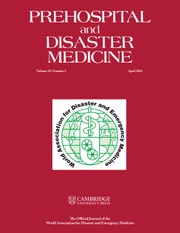No CrossRef data available.
Article contents
Designing an EMT Cache for Extreme Cold Weather in Mongolia
Published online by Cambridge University Press: 21 May 2025
Abstract
Emergency Medical Team (EMT) cache is the collection of items and equipment that enable an EMT to remain operational and self-sufficient during deployment. Providing quality care to affected populations and ensuring that WHO standards are upheld is of primary concern. Cache design needs to be specific to context. With extreme winter conditions in Mongolia with temperatures below -30°C from November to February, special attention had to be taken into consideration when designing the EMT cache.
Design cache content for EMT type 1 fixed to respond to disasters fit for extreme cold weather conditions. Mongolia regularly experiences these events, an extreme cold-season disaster where heavy snow and ice cover lead to reduced accessibility of health services, and high livestock mortality.
Specialized items including insulated tents, sleeping bags, heated flooring, air heaters, insulated water conduits are some of the items necessary to prevent freezing and prevent equipment damage from exposure to extreme cold.
Consultation was done with cold climate EMT experts, the Mongolian Ministry of Health, the National Emergency Management Agency, and the Ministry of Defense.
The Mongolia EMT cache was successfully designed and procured by the WHO. Under the ownership of the Ministry of Health, all cache items were delivered to the National health sector warehouse in Ulaanbaatar.
EMT equipment adapted to cold climate is significantly more costly and bulkier, requiring adapted logistics for successful deployment.
Through a consultative process and strategic design, the Mongolia EMT cache is now ready for deployment during the harsh winter season in Mongolia.
Information
- Type
- Meeting Abstracts
- Information
- Copyright
- © The Author(s), 2025. Published by Cambridge University Press on behalf of World Association for Disaster and Emergency Medicine


